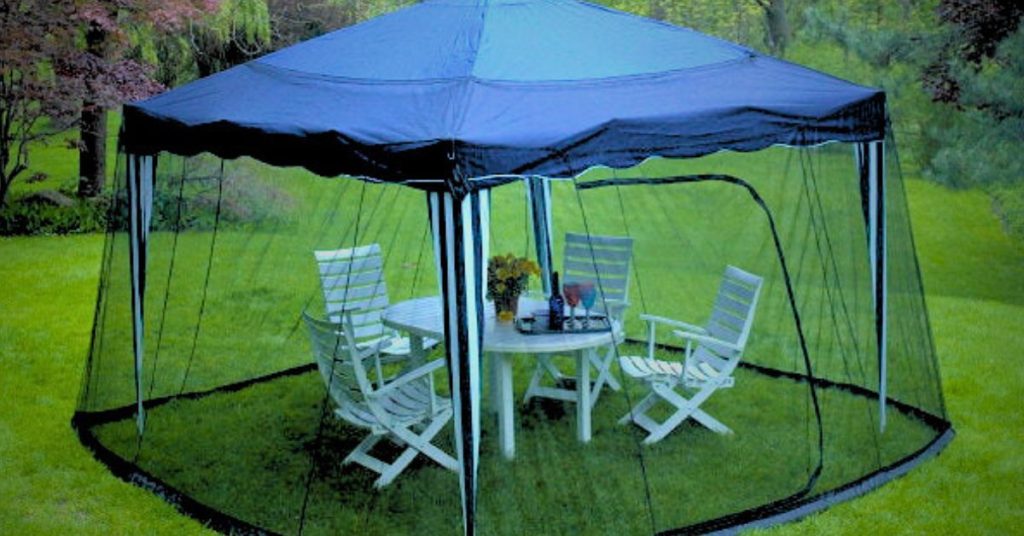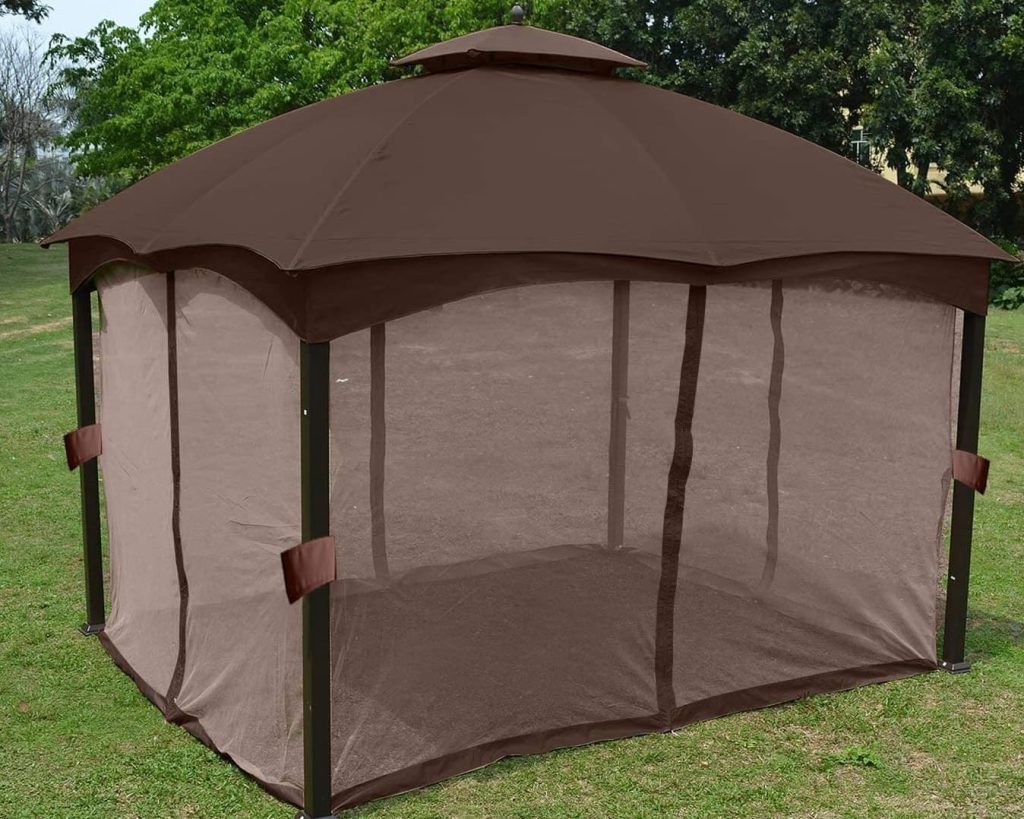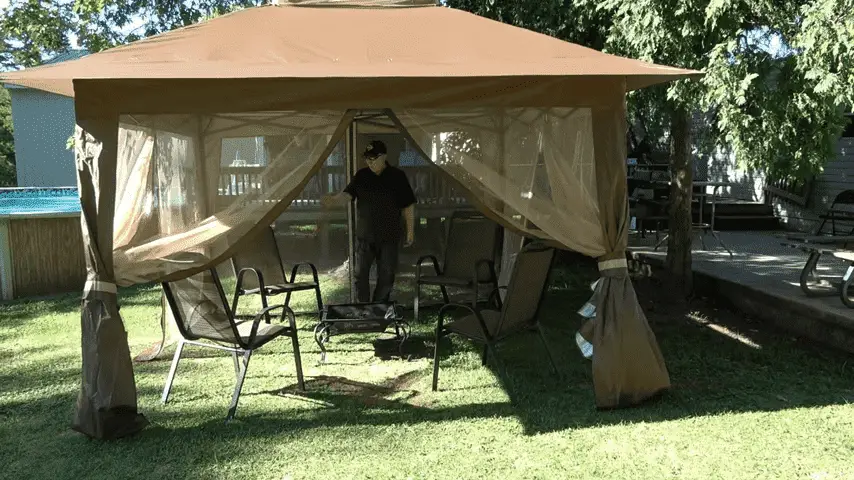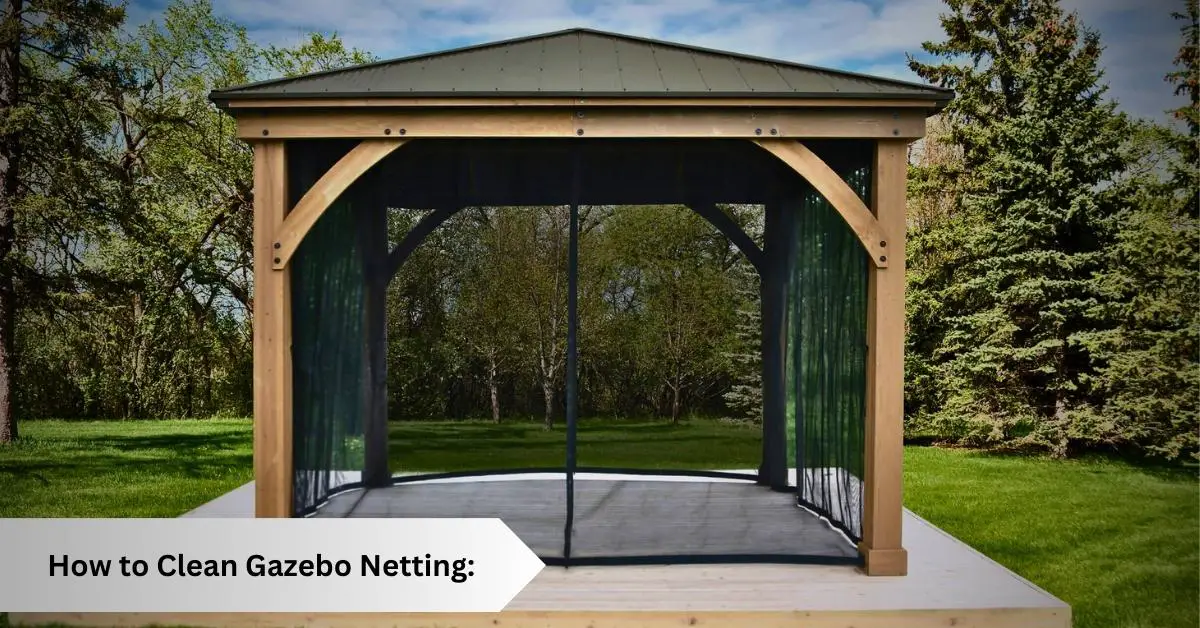Gazebo netting is an essential component of an outdoor gazebo, protecting insects and pests while allowing for an open-air experience. Over time, however, the netting can become dirty and unsightly, affecting its functionality and appearance.
Regular cleaning of gazebo netting is crucial to keep it in excellent condition and prolong its lifespan. This article provides a step-by-step guide on how to clean gazebo netting effectively and preventive maintenance tips to help keep your netting looking great for years to come.
Following these tips, you can enjoy your gazebo without distractions from unsightly netting.
How to Clean Gazebo Netting: Cleaning gazebo netting is important to keep your outdoor space comfortable and enjoyable. To clean it, remove the netting from the frame, brush off loose debris, scrub with a mild detergent and soft-bristled brush, rinse thoroughly, and let it air dry completely before reinstalling it onto the gazebo frame.
Gazebo Netting: Definition

Gazebo netting is a mesh or fabric material that surrounds an outdoor gazebo, protecting against bugs, insects, and other pests while still allowing for an unobstructed view and fresh air.
The netting is typically made from durable materials such as polyester, nylon, or vinyl and can be attached to the gazebo frame with Velcro, zippers, or clips. Gazebo netting is available in different shapes and sizes, depending on the gazebo’s design and specifications.
The netting is an essential component of a gazebo, providing comfort, protection, and functionality for outdoor gatherings and relaxation. However, the netting can become dirty and unsightly over time, and regular cleaning is necessary to maintain its functionality and appearance.
Importance of Cleaning Gazebo Netting for Function and Appearance

Regular cleaning of gazebo netting is essential to maintain its functionality and appearance. Over time, dirt, dust, and debris can accumulate on the netting, affecting its transparency and hindering fresh air flow.
Additionally, insects and pests can leave stains and residue on the netting, making it unsightly and unpleasant.
Cleaning the netting not only improves its appearance but also prevents the buildup of mold and mildew, which can affect the netting’s durability and lifespan.
Moreover, regular cleaning helps to keep the netting free from unpleasant odors and allergens, ensuring a comfortable and safe environment for outdoor relaxation and gatherings.
By cleaning the gazebo netting regularly, you can prolong its lifespan and ensure it provides maximum protection and comfort for years to come.
Materials and Tools Needed
To clean gazebo netting effectively, you will need the following materials and tools:
- Bucket
- Mild detergent or soap
- Soft-bristle brush
- Garden hose with a gentle spray attachment
- Clean cloth or towel
These items are readily available and can be purchased from most hardware or home improvement stores. Using gentle and non-abrasive materials and tools is essential to avoid damaging the netting’s delicate fibers.
Step-by-Step Guide on How to Clean Gazebo Netting
Cleaning your gazebo netting can be a simple process if you follow these steps:
1. Preparation
Before cleaning the gazebo netting, it is important to prepare the area and ensure you have all the necessary materials and tools. Firstly, remove any outdoor furniture or objects near the gazebo to avoid accidental damage.
Next, set up a workspace and lay down a tarp or cloth to catch any debris that may fall during the cleaning process. Ensure you have a bucket filled with warm water, mild detergent or soap, a soft-bristle brush, a garden hose with a gentle spray attachment, and a clean cloth or towel for drying.
It is also recommended to wear gloves to protect your hands from any chemicals or dirt that may come into contact with the skin. Proper preparation sets the stage for an efficient and effective cleaning process.
2. Removing Debris and Dust
The first step in cleaning gazebo netting is to remove any debris and dust that may have accumulated on the netting. Use a soft-bristle brush to remove any dirt or dust from the netting gently.
Start from the top and work your way down, brushing downward to avoid pushing the debris further into the netting. Be gentle while brushing to avoid damaging the netting or the gazebo frame.
If the debris is too stubborn, you can use a vacuum cleaner with a soft-bristle attachment to suck up the dirt and dust. Clean the brush or attachment before using it on the net to avoid transferring debris from other surfaces.
Once you have removed as much debris and dust as possible, you can move on to the next step in the cleaning process.
3. Applying the Detergent Solution
Fill a bucket with warm water and add a mild detergent or soap, such as a dish or laundry. Mix the solution well until it forms a lather. Dip the soft-bristle brush into the detergent solution and gently scrub the netting in circular motions, starting from the top and working your way down.
Be sure to cover all areas of the netting, including the corners and seams.
You may need a stronger cleaning solution or a stain remover if the netting is heavily soiled or stained. However, be careful not to use bleach or harsh chemicals that can damage the netting’s fiber
4. Rinsing with a Garden Hose

After applying the detergent solution, it’s time to rinse the gazebo netting with a garden hose. Use a gentle spray attachment on the hose and start at the top of the netting, working your way down to avoid missing any spots.
Ensure the water pressure is not too high, which can damage the netting. Continue rinsing until all the soap residue is removed and the water clears.
Take your time while rinsing to remove all the soap residue, as any remaining residue can attract more dirt and debris.
Be thorough but gentle while rinsing to avoid damaging the netting or the gazebo frame. Once you have finished rinsing, turn off the hose and move on to the final step in the cleaning process.
5. Drying the Netting
The final step in cleaning the gazebo netting is to allow it to dry completely. You can use a clean towel or cloth to gently pat the netting dry, but be careful not to rub it too hard, as this can damage the netting.
It’s best to let the netting air dry naturally, but if you’re in a hurry, you can use a fan or a hairdryer set to a cool setting to speed up the process. Avoid using high heat or leaving the netting in direct sunlight, as this can cause the material to shrink or become brittle.
Once the netting is completely dry, reattach it to the gazebo frame and enjoy a fresh and clean outdoor space.
Preventive Maintenance Tips
To keep your gazebo netting in good condition and reduce the need for frequent cleaning, there are some preventive maintenance tips that you can follow. Regularly cleaning the surrounding area and removing debris or dirt can help prevent it from accumulating on the netting.
It’s also important to trim overhanging trees or shrubs, as their branches can scratch or tear the netting. During the off-season or when not in use, storing the netting in a dry and cool place is recommended to prevent mold and mildew growth.
Applying a water-repellent or UV protection spray can also help prolong the netting’s lifespan and maintain its appearance. By following these preventive maintenance tips, you can keep your gazebo netting clean and functional for longer, saving you time and effort in the long run.
To keep your gazebo netting clean and in good condition, here are some preventive maintenance tips to follow:
1. Regular cleaning of the surrounding area
Regularly cleaning the surrounding area is crucial in preventing dirt, debris, and other contaminants from accumulating on the gazebo netting. It is essential to sweep or blow away leaves, twigs, and other debris regularly, as they can easily get stuck in the netting and attract insects and pests.
Additionally, trimming overhanging trees or shrubs can prevent leaves and branches from falling onto the netting, minimizing the amount of debris that needs to be cleaned. By keeping the surrounding area clean, you can reduce the frequency and intensity of cleaning required for the netting, making the process easier and more efficient.
2. Trimming overhanging trees or shrubs

In addition to regular cleaning, trimming overhanging trees or shrubs around your gazebo can help prevent debris and leaves from accumulating on the netting.
Overhanging branches can also rub against the netting, causing damage or tears. Trimming them back keeps the area clean and ensures the netting remains intact and functional for longer.
When trimming, use appropriate tools and equipment, and avoid cutting too close to the pavilion or damaging any nearby plants or structures.
Regularly maintaining the surrounding area can help keep your gazebo and netting in top shape, providing a clean and comfortable outdoor space for relaxation and entertainment.
3. Proper storage during the off-season
Proper storage of the gazebo netting during the off-season is essential for its longevity and durability. Before storing the netting, it is crucial to ensure it is clean and completely dry to prevent the growth of mold and mildew.
The netting should be folded or rolled neatly and placed in a storage bag or container, ideally in a cool and dry place away from direct sunlight. It is also essential to keep the netting away from any sharp or rough objects that may damage it.
Proper storage ensures the netting remains in good condition and saves time and effort when preparing the gazebo for the next season.
4. Applying water repellent or UV protection spray
To further protect the gazebo netting, it’s recommended to apply a water-repellent or UV protection spray. These sprays can help to prevent water from seeping into the netting and causing mold or mildew growth.
Additionally, UV protection sprays can help to prolong the netting’s lifespan by protecting it from the damaging effects of the sun’s UV rays. It’s important to choose a spray that is safe for use on the netting material and to follow the instructions carefully.
Generally, these sprays are applied by evenly spraying the netting and allowing it to dry completely before use. By regularly applying these sprays, you can help to maintain the netting’s durability and appearance.
FAQs
Q.1 How to deal with heavily stained or soiled netting?
If your gazebo netting is very dirty or has tough stains, you might need to use a stronger cleaner that is made for outdoor materials like polyester, nylon, or vinyl. You can find these cleaners at hardware or outdoor stores.
Use a soft brush or sponge to apply the cleaner and follow the instructions on the label. Before applying it, test a small spot to see if it’s okay. If the stains don’t disappear, you might need to clean it again or consider getting new netting.
Q.2 Can you bleach mosquito netting?
To clean a bed net, use plain soap and water. Don’t use bleach or other detergents because they can make the insecticide used to treat the net less effective. Be gentle when cleaning the net so you don’t accidentally tear it.
Q.3 How do you clean net mesh?
Mix one part of ammonia with three parts of water to make a cleaning solution for your window screens. Pour the solution into a spray bottle. Spray the window screens generously with the solution, then wipe them with a soft cloth. You’ll be surprised at how clean and shiny your mosquito nets for windows will look!
Conclusion
In conclusion, gazebo netting is an essential component of any outdoor gazebo, protecting against bugs, insects, and other pests while still allowing for an unobstructed view and fresh air. However, the netting can become dirty and unsightly over time, affecting its functionality and appearance.
Regular cleaning of the netting is necessary to maintain its transparency, prevent mold and mildew buildup, and prolong its lifespan. Cleaning gazebo netting can be a simple process with the right tools and materials.
In addition to regular cleaning, preventive maintenance tips such as cleaning the surrounding area, trimming overhanging trees or shrubs, proper storage during the off-season, and applying water repellent or UV protection spray can help keep the netting in excellent condition for years.
Following the step-by-step guide and preventive maintenance tips outlined in this article, you can ensure that your gazebo netting provides maximum protection, comfort, and functionality, enhancing outdoor relaxation and gatherings.
We trust that this comprehensive guide on How to Clean Gazebo Netting has provided you with a clear understanding. Should you have any inquiries, please don’t hesitate to leave a comment below!


